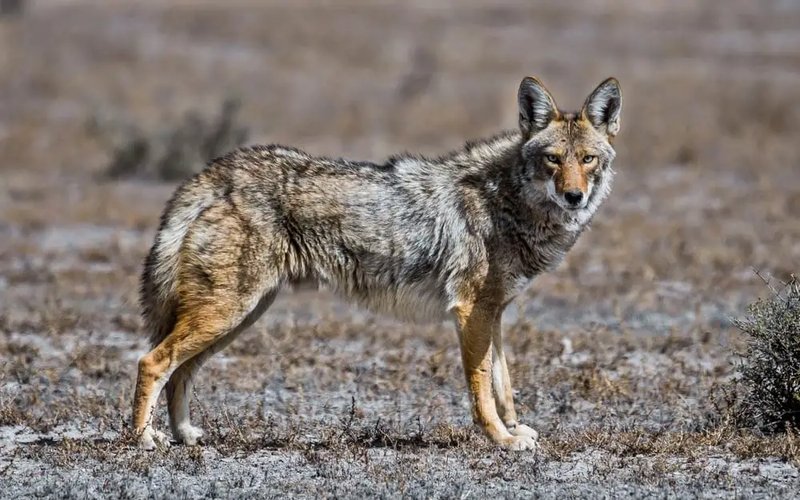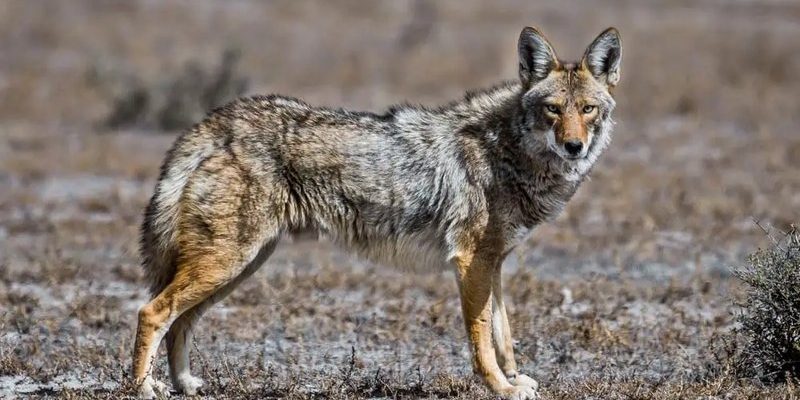
Think of it like a game of “Guess Who?”, where you learn to differentiate these animals based on their looks, behaviors, and habitats. You might expect them to all be similar, but there are some key differences that will help you recognize each one. Whether you’re an aspiring wildlife enthusiast or just curious about your local wildlife, this guide will help you appreciate the diversity of creatures that roam our planet.
1. Wolves
Wolves are perhaps the closest relatives to coyotes. They share a similar body structure and are members of the same family, Canidae. One of the most notable differences is their size—wolves are typically much larger than coyotes. An adult wolf can weigh between 50 to 100 pounds, while a coyote usually tops out around 40 to 50 pounds.
In terms of fur, both animals can have a mix of browns, grays, and blacks, but wolves often have thicker coats that help them survive in colder climates. If you encounter a pack, you may notice their social behavior: wolves are highly social and often hunt in groups, while coyotes are more solitary or might hunt in small family units. You might be wondering how to spot them in the wild. Look for wolf tracks, which are larger and more rounded than coyote tracks.
2. Foxes
Foxes, especially the red fox, can sometimes be mistaken for coyotes due to their bushy tails and pointed ears. However, they’re generally smaller and have a more slender build. Adult red foxes usually weigh between 8 to 24 pounds, which is a stark contrast to coyotes.
What’s fun about foxes is their playful nature. They often engage in a behavior called “mousing,” where they leap into the air and pounce on prey hidden in the snow. Their fur is more vibrant, often with reddish and orange hues, compared to the coyotes’ more muted shades. If you think you’ve spotted a coyote, but it appears to be smaller and has a bushy tail, chances are you’re looking at a fox!
3. Domestic Dogs
Surprisingly, many domestic dog breeds share similarities with coyotes. Dogs and coyotes are closely related, and you’ll see some resemblance in size and shape in breeds like the German Shepherd or Alaskan Malamute. However, domestic dogs come in various sizes and temperaments, making them quite distinct.
One way to tell them apart is behavior. While coyotes are typically wary of humans, many dogs are eager to interact. Additionally, coyotes possess a more slender snout and longer legs compared to many stocky dog breeds. If you’re unsure whether you’ve encountered a coyote or a dog, watch how they behave. If it’s social and playful, you might just be dealing with a canine companion.
4. Jackals
Jackals might not be as familiar to you, but they share a family tree with coyotes. Found mainly in Africa and parts of Asia, jackals resemble coyotes in size and shape but have distinctive fur patterns. Their coats often display a mix of yellow and brown, making them stand out in their native habitats.
The behavior of jackals is also worth noting. They are known for their scavenging habits and will often work in pairs or small groups, unlike the more solitary lifestyle of coyotes. If you ever spot one, notice the wolf-like features, but keep an eye out for their bushy tails and shorter legs compared to coyotes.
5. Dingoes
Dingoes are wild dogs native to Australia and have some striking similarities to coyotes. They have similar body shapes and slender builds, which can make them look alike at first glance. Dingoes generally weigh between 30 to 40 pounds, placing them in a similar weight range as coyotes.
One key difference is their coat color; dingoes often have a sandy or ginger coloration. Unlike coyotes, dingoes are more adapted to warm climates, which affects their behavior and hunting patterns. If you’re lucky enough to see one in the wild, pay attention to their more rounded ears, which can help you identify them over a coyote.
6. Coywolves
You might be scratching your head at this name—coywolves! This hybrid is a mix between coyotes and wolves, primarily found in the northeastern United States. These animals can take on the physical traits of both parents, often looking like a larger coyote.
Coywolves are typically larger than a standard coyote but smaller than a wolf, weighing around 50 to 75 pounds. Their adaptations to urban environments make them fascinating. If you see a larger coyote with some wolf-like features, it could be a coywolf. Their adaptability to both rural and urban areas is impressive and shows just how versatile these animals can be.
7. African Wild Dogs
African wild dogs, also known as painted wolves, are another interesting animal that shares similarities with coyotes. While they are larger, their social structure mirrors that of coyotes. African wild dogs hunt in packs, relying on teamwork to catch prey, much like a family of coyotes.
Their coats are a mix of brown, black, yellow, and white, making them easily distinguishable. They have large, rounded ears that help with hearing over long distances. If you see a pack of these dogs, they’re more likely to be vocal and social, engaging in play and communication that differs from the more solitary coyotes.
8. Ocelots
Although ocelots are actually felines and much smaller than coyotes, they offer an interesting comparison due to their similar habitats and behaviors. Ocelots are often found in dense forests and jungles, where they camouflage well with their spotted fur.
Unlike coyotes, ocelots are solitary hunters. They primarily hunt small mammals and birds. If you notice a cat-like creature with striking spots, you’re likely looking at an ocelot, not a coyote. While they share the same regions, their hunting methods and physical structures can help you easily tell them apart.
9. Raccoons
Raccoons are another animal that might have a similar size to coyotes, especially young ones. Although they are not canines, they can sometimes be confused due to their adaptable nature. Raccoons are known for their distinctive masked faces and bushy tails.
While coyotes are primarily carnivorous, raccoons are omnivorous and will eat anything from fruits to small rodents. If you see a creature rummaging through trash or climbing a tree, you’re probably looking at a raccoon instead of a stealthy coyote. Just remember, the telltale mask is a clear giveaway!
10. Hyenas
Finally, let’s discuss hyenas, which often get a bad rap due to their reputation in popular culture. While larger than coyotes, they share some similar social and hunting behaviors. Hyenas live in clans and have a complex social structure, much like coyotes do in their family units.
Although they are more closely related to felines than canines, they do share a few physical traits. A hyena’s long legs and strong jaws make them impressive hunters. If you see an animal that resembles a coyote but has a stockier build and a distinct laugh-like sound, it’s likely a hyena.
In conclusion, understanding the various animals similar to the coyote can enhance your appreciation for wildlife. Whether you’re hiking in the wilderness or just curious about animal behaviors, knowing how to distinguish these creatures can add a new layer of enjoyment to your outdoor adventures. Remember, each animal has its unique traits and behaviors, and with a little observation, you’ll be able to tell them apart!

